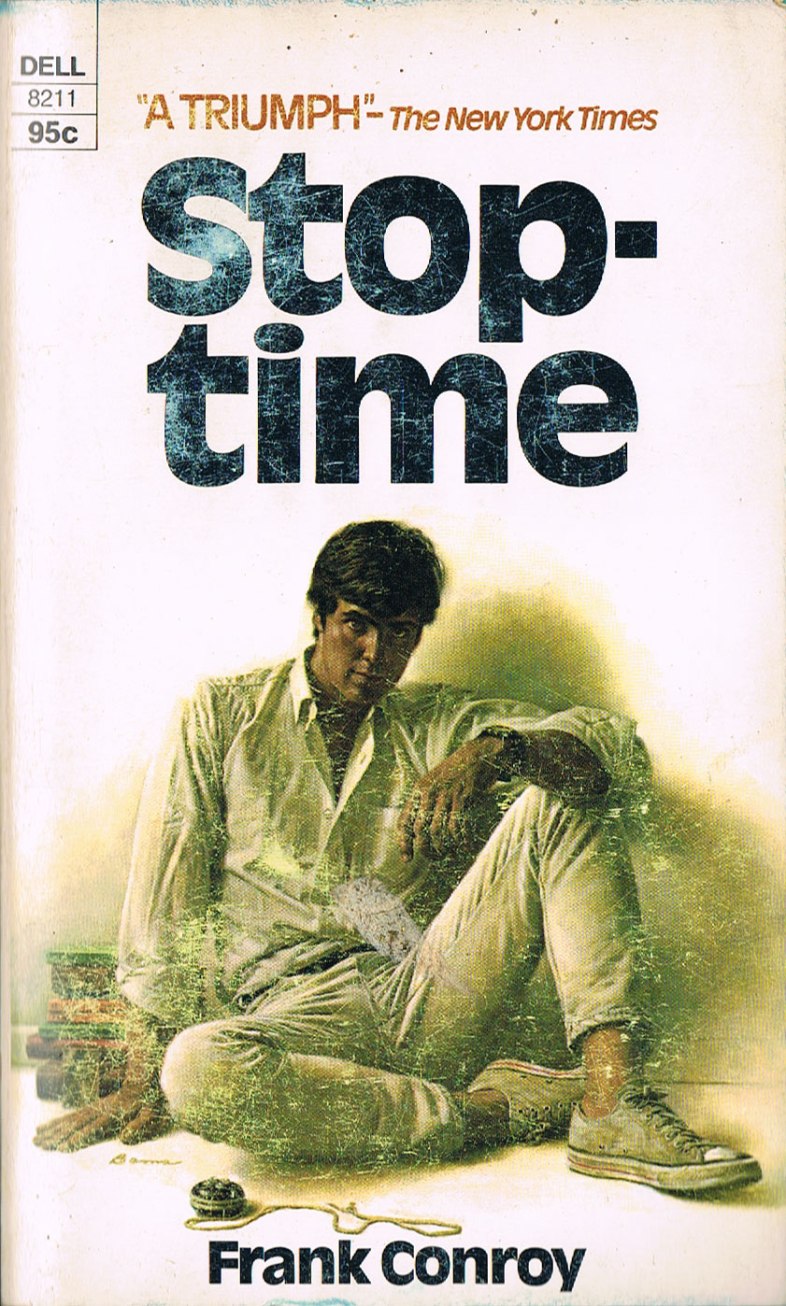- Frank Conroy Stop Time Deutsch
- Frank Conroy Author
- Frank Conroy Stop Time Pdf
- Frank Conroy Stop Time Summary
Coming of Age
This is the book's central theme, the focus of both its narrative and emotional through-line. The book is, essentially, the author's episodic recounting of contexts, relationships and incidents that contributed to his transformation from childhood to young adulthood, a transformation at the core of many similar narratives. 'Coming of age' is, in other words, a universal or archetypal story, one familiar to everyone who has ever become an adult, or one who will become familiar to everyone who has yet to do so.
Frank Conroy (January 15, 1936 – April 6, 2005) was an American author. He published five books, including the highly acclaimed memoir Stop-Time. Published in 1967, this ultimately made Conroy a noted figure in the literary world. The book was nominated for the National Book Award. Frank Conroy was born in 1936 and graduated from Haverford College in 1958. He was director of the prestigious Writers' Workshop. Conroy wrote an autobiography Stop-Time, published in 1967, and his collection of stories, Midair, was published in 1985. His work has appeared in the New Yorker, Esquire, GQ, Harper’s Magazine, and Partisan Review.
‘‘Stop-time’’ is a memoir which was written by an American author by the name; Frank Conroy. The book tells Conroy’s childhood experiences while growing up between Florida and New York was published in 1967. Conroy’s story can be related to contemporary times where thousands of American children go through a lot of emotional turmoil. First published in 1967, Stop-Time was immediately recognized as a masterpiece of modern American autobiography, a brilliant portrayal of one boy's passage from childhood to adolescence and beyond.
Within such archetypal stories, there are also archetypal experiences, many of which are encountered by the author in the pages of the book. These include the awareness of death, awareness of adult versions of emotions like hate, and the transfer of interest from childish, playful pastimes into more adolescent pastimes related to sex. The author also has the archetypal experiences of discovering the...
Frank Conroy Stop Time Deutsch
In tap dancing, jazz, and blues, stop-time is an accompaniment pattern interrupting, or stopping, the normal time and featuring regular accented attacks on the first beat of each or every other measure, alternating with silence or instrumental solos.[3] Stop-time occasionally appears in ragtime music.[2] The characteristics of stop-time are heavy accents, frequent rests, and a stereotyped cadential pattern.[1]Stop-timing may create the impression that the tempo has changed, though it has not, as the soloist continues without accompaniment.[4] Stop-time is common in African-American popular music including R&B, soul music, and led to the development of the break in hip hop.[5]
Stop-time is, according to Samuel A. Floyd Jr., 'a musical device in which the forward flow of the music stops, or seems to stop, suspended in a rhythmicunison, while in some cases an improvising instrumentalist or singer continues solo with the forward flow of the meter and tempo. Such stop-time moments are sometimes repeated, creating an illusion of starting and stopping, as, for example, in Scott Joplin's 'The Ragtime Dance' and Jelly Roll Morton's 'King Porter Stomp'.'[5]

Joplin's 'Stoptime Rag' (1910) employs stop-time throughout; it even lacks his characteristic four-bar introduction. Stop-time in Joplin's rags is characterized by directions in the music for performers to stomp their foot to the beat. The sheet music for Joplin's 'Ragtime Dance' contains the direction,[6] 'Notice: to get the desired effect of 'stop time', that the pianist will please stamp the heel of one foot heavily upon the floor at the word 'stamp'. Do not raise the toe from the floor while stamping.'
In his copyright submission for 'Cornet Chop Suey,' Louis Armstrong includes a written stop-time chorus.[7] Allusions to the stop-time chorus of 'Cornet Chop Suey' occurs in 'Oriental Strut'[8] and 'Potato Head Blues.' Thomas Brothers cites Armstrong's exposure to the tap-dancing of Bubbles, who improvised dance steps during stop-time choruses, at the Sunset Café as further inspiration for stop-time choruses in his repertoire.[9]

In Signifyin(g), Sanctifyin', and Slam Dunking, Gena Dagel Caponi writes:
In this music [Africa-American spirituals] the fundamental beat chiefly maintained by the patting of one foot, while the hands clap out intricate and varying rhythmic patterns. It should be understood that the foot is not marking straight time, but what Negroes call 'stop time', or what the books have no better definition for than 'syncopation'. The strong accent or down beat is never lost, but is playfully bandied from hand to foot and from foot to hand.[10]


See also[edit]
Frank Conroy Author

- Son clave, a cross-rhythm of which stop-time is a simplification
References[edit]
Frank Conroy Stop Time Pdf
- ^ abBerlin, Edward A. (2002). Ragtime: A Musical and Cultural History, p.19–41. ISBN0-595-26158-2.
- ^ abcBerlin (2002), p.109.
- ^Randel, Don Michael; ed. (2003). The Harvard Dictionary of Music, p.841. ISBN0-674-01163-5.
- ^Gridley and Cutler (2003). Jazz Styles: History and Analysis, p.15. ISBN0-13-099282-8.
- ^ abRamsey, Guthrie Jr. 'Stop-Time!' (Fall 1998), Colum.edu.
- ^Hiscock and Metcalfe (1998). New Music Matters 11-14, p.61. ISBN0-435-81090-1.
- ^Brothers, Thomas (2014). Louis Armstrong: Master of Modernism. New York, NY: W.W. Norton & Company. p. 111. ISBN978-0-393-06582-4.
- ^Brothers, Thomas (2014). Louis Armstrong: Master of Modernism. New York, NY: W.W. Norton & Company. p. 208. ISBN978-0-393-06582-4.
- ^Brothers, Thomas (2014). Louis Armstrong: Master of Modernism. New York, NY: W.W. Norton & Company. pp. 264–67. ISBN978-0-393-06582-4.
- ^Caponi, Gena Dagel (1999). Signifyin(g), Sanctifyin', and Slam Dunking, p.62. University of Massachusetts. ISBN9781558491830.
Frank Conroy Stop Time Summary
